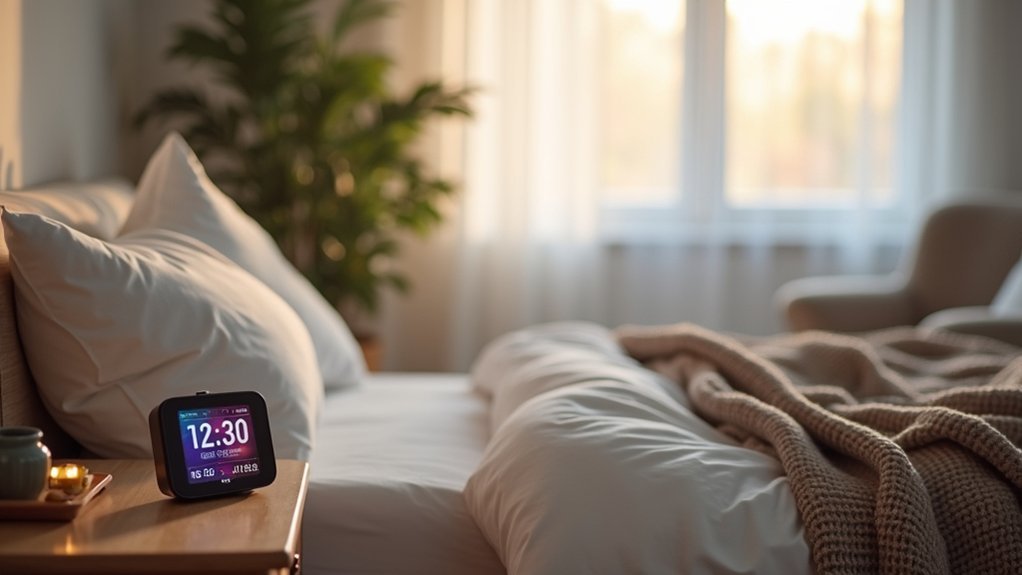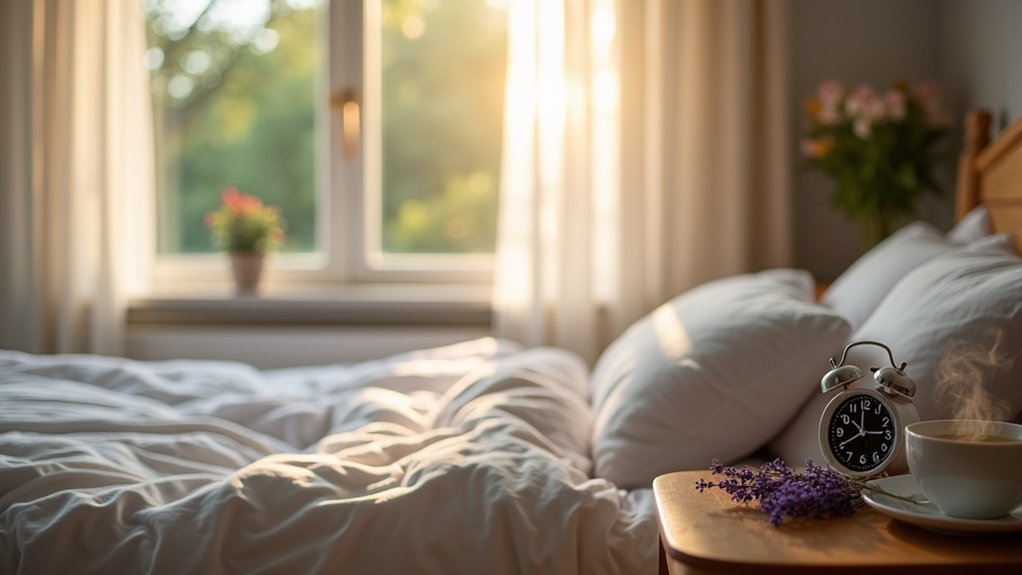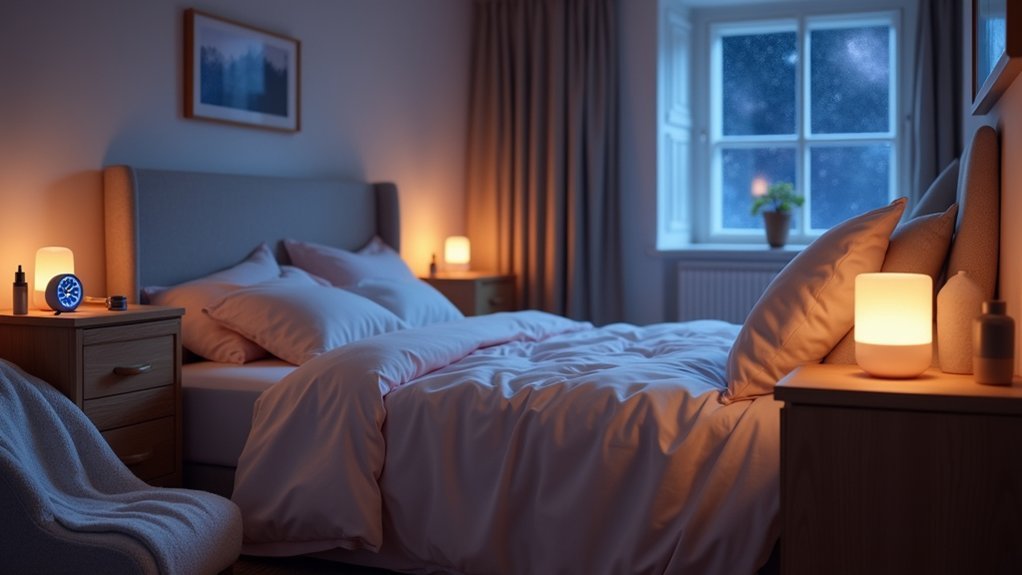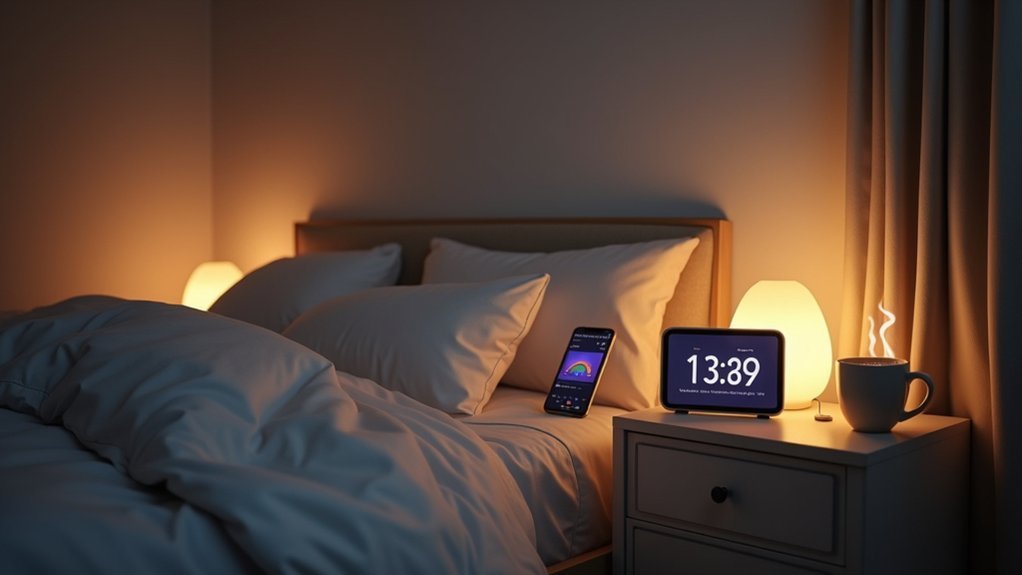To maximize your Sleep Cycle alarm tracker, position your device consistently near your torso with microphones facing up. Set a 30-minute wake-up window for gentle arousal during light sleep. Personalize alarm sounds and review your sleep statistics regularly to identify patterns. Track lifestyle factors like caffeine and exercise in sleep notes. Sync with fitness apps for thorough health insights. Connect multiple devices through Bluetooth for the most accurate tracking. These optimization strategies are just the beginning of your journey toward better sleep.
7 Tips: Ultimate Sleep Cycle Alarm Tracker Guide

Four essential strategies can revolutionize your experience with Sleep Cycle’s alarm tracker.
First, optimize your wake-up window by selecting a 30-90 minute timeframe that aligns with your morning routine, allowing the app to wake you during your lightest sleep phase.
Second, personalize your alarm sounds—choose from the app’s library or use your favorite songs for a gentler awakening experience.
Third, leverage the sleep notes feature to document factors like caffeine intake, stress levels, or exercise that might impact your sleep quality. The app’s patented sound technology also captures snoring and sleep talking, providing additional insights into your sleep quality.
This data becomes invaluable when analyzing trends.
Finally, consistently review your sleep statistics.
Pay attention to your hypnogram displays and quality scores to identify patterns and make informed lifestyle adjustments.
The AI-powered tracking provides actionable insights that can greatly improve your sleep habits over time.
Positioning Your Device for Optimal Sleep Tracking Accuracy
Positioning your sleep tracker correctly can greatly improve its accuracy, with wearables requiring consistent body contact and nearables needing strategic room placement.
You’ll need to balance stability (keeping the device in one position throughout the night) with sensitivity (ensuring sensors can properly detect your movements and biosignals).
Consider your specific device type—whether it’s a wrist-worn tracker, under-mattress sensor, or bedside monitor—as each has unique ideal placement requirements that affect its ability to capture accurate sleep data.
Despite their convenient design, commercial sleep trackers often struggle with accuracy when detecting wake periods during the night, which can impact the overall sleep quality assessment.
Ideal Placement Options
The way you position your sleep tracking device dramatically affects its accuracy and the reliability of your sleep data. For wearables, your non-dominant wrist provides the best balance between comfort and accuracy, ensuring consistent skin contact throughout the night.
If you’re using a nearable device like the Withings Sleep Mat or Amazon Halo Rise, place it at chest level under your mattress or on your bedside table within two meters of your body.
Smartphone apps work best when positioned on your mattress near your torso with the microphone facing your head. The Oura Ring should be worn on the pointer finger with sensor bumps facing inward for optimal tracking results.
- Trust your comfort – A device that irritates you undermines the very sleep it aims to track.
- Maintain consistency – Changing placement nightly introduces unwanted variables.
- Prioritize signal clarity – Keep other electronics away from your tracking zone.
Stability vs. Sensitivity
When choosing the perfect spot for your sleep tracker, you’ll need to balance two critical factors: stability and sensitivity. Stability guarantees consistent data over time, while sensitivity determines how well your device detects movements during sleep.
For best results, maintain consistent device placement each night. Wearables should be snug but comfortable, while nearables and airables need proper positioning relative to your body.
Remember that highly sensitive settings can detect minor disturbances but may overreport restlessness. Fitbit offers both Normal and Sensitive modes to accommodate different sleep tracking needs and preferences.
Different brands offer varying levels of performance—Fitbit typically provides better sensitivity than Garmin, while devices like Amazon Halo Rise show moderate agreement with sleep stage classification.
If you wake feeling unrested despite good sleep reports, try adjusting to a more sensitive setting to capture disruptions your tracker might miss.
Customizing Your Wake-Up Window for Natural Arousal

At the heart of Sleep Cycle’s effectiveness lies its customizable wake-up window, designed to gently rouse you during your lightest sleep phase.
While the default 30-minute window works for most users, you can tailor this between 10-45 minutes based on your sleep patterns and schedule needs. The app achieves this by monitoring sleep phases through advanced sound detection that tracks your movements in bed.
Light sleepers benefit from extended 30-45 minute windows, providing more opportunities to catch ideal waking moments.
Heavy sleepers may prefer shorter 10-15 minute windows to minimize schedule disruption while still targeting lighter sleep phases.
- Feel refreshed by aligning your window with your natural REM cycles
- Reduce morning grogginess through precise timing of your lightest sleep stage
- Gain control over your morning routine without sacrificing sleep quality
For best results, maintain consistent bedtimes regardless of your chosen window length.
Interpreting Your Sleep Data to Improve Rest Quality
Your sleep data reveals essential patterns that can transform your nightly rest when properly interpreted.
By understanding your sleep score metrics, you’ll identify which factors most markedly impact your sleep quality and make targeted improvements.
Track how your daily habits affect these metrics to develop a personalized strategy that optimizes your sleep environment and bedtime routine for consistently better rest. Maintaining a consistent wake-up time helps regulate your body’s internal clock and can significantly improve your overall sleep quality.
Interpreting Your Sleep Data to Improve Rest Quality
Interpreting sleep data effectively transforms how you understand and improve your rest quality.
By establishing your personal sleep stage baseline, you’ll identify what makes you feel genuinely rested rather than chasing arbitrary targets. Your sleep tracker reveals connections between lifestyle choices and sleep patterns, helping you make targeted adjustments to bedtime routines. Typical healthy sleep distribution consists of approximately 75% non-REM and 25% REM sleep, though individual variation is normal.
- Recognize disruption patterns – Finding that you wake frequently between 2-4 AM can reveal stress triggers or environmental factors affecting your deepest sleep phases.
- Connect the dots – Notice how exercise timing, screen exposure, or evening meals correlate with your REM and NREM percentages.
- Implement data-driven changes – Use your personal insights to create a sleep environment and routine specifically designed for your unique sleep architecture.
Decode Sleep Score Metrics
Understanding sleep score metrics empowers you to transform numerical data into actionable insights about your rest quality. Your overall score (0-100) combines several key components, with 85+ indicating ideal rest.
Look beyond the headline number to examine sleep efficiency—the percentage of in-bed time you’re actually sleeping. Pay attention to your sleep stages distribution, as balanced proportions of REM (mental restoration) and deep sleep (physical recovery) greatly impact your mind and body scores.
Consider your restfulness metrics, which track disturbances like tossing and turning that fragment sleep. Sleep latency (time to fall asleep) and timing (alignment with your natural rhythms) also affect your score. While analyzing your sleep metrics, remember that nightly HRV graphs provide valuable insights into your body’s recovery patterns during rest.
Consistently low scores (below 70) highlight specific areas needing improvement, helping you target lifestyle changes for better rest.
Track Lifestyle Impact Patterns
Analyzing sleep data becomes truly powerful when you connect it to your daily habits and lifestyle choices. Your sleep tracker can reveal patterns that explain why some nights you sleep like a rock while others leave you tossing and turning.
When reviewing your sleep metrics, pay special attention to these lifestyle factors:
- Nutrition timing and content – Late-night high-fat meals and caffeine after 2pm correlate strongly with disrupted sleep architecture and reduced REM sleep. Studies consistently show that diets high in saturated fat and sugar significantly reduce deep sleep quality.
- Physical activity patterns – Regular moderate exercise improves sleep efficiency, while both sedentary behavior and late-night intense workouts can compromise quality rest.
- Screen exposure before bed – Your pre-sleep social media scrolling suppresses melatonin and extends sleep latency, particularly if you’re over 30.
Integrating Sleep Cycle Tracking With Your Fitness Routine
How effectively you combine your sleep data with fitness tracking can dramatically enhance your overall wellness journey.
Sleep Cycle automatically pulls step data from Apple Health (iOS) or Google Fit (Android) since your last sleep session, creating a thorough picture of your activity levels.
Check your device settings to manage how Sleep Cycle accesses your fitness data. You can’t manually add step data after closing a sleep session, so verify it’s properly recorded in your health app.
The app’s integration with platforms like MyFitnessPal connects your diet, fitness, and sleep data.
Use Sleep Notes to log workouts and track their impact on your sleep quality. For iOS users, you can disable step tracking completely by adjusting your Motion & Fitness settings in the Privacy menu. Features like snore tracking and cough radar provide insights into how exercise affects your breathing patterns during rest.
Leveraging Sleep Sounds and Aids for Deeper Relaxation

Sleep quality doesn’t just depend on tracking your cycles—it can be dramatically enhanced by the sounds you choose to accompany your slumber.
Whether you prefer nature sounds like rainfall and ocean waves, or consistent white and pink noise to mask environmental disturbances, finding your perfect sound environment can transform your sleep experience. Personal preference is the key factor since sound preferences vary significantly between individuals.
Your sleep tracker app can work alongside dedicated sound machines or apps like Calm to create an ideal sleep environment.
For maximum effectiveness:
- Choose consistent sounds that your brain will learn to associate with sleep
- Experiment with different options – from ASMR to guided meditations – until you find what works best for you
- Keep volumes low (under 40 decibels as recommended by WHO) to make sure the sounds aid rather than disturb your sleep
Syncing Multiple Devices for Comprehensive Health Monitoring
While tracking your sleep patterns offers valuable insights, connecting your Sleep Cycle app with other health monitoring devices creates a powerful ecosystem that reveals the entire picture of your wellbeing. By leveraging Bluetooth connectivity and cloud integration, you’ll gain real-time updates and personalized recommendations. However, be aware that syncing multiple devices can sometimes lead to data replacement issues when historical information is involved.
| Device Type | Benefits | Synchronization Method |
|---|---|---|
| Heart Rate Monitors | Correlates sleep quality with cardiac health | Bluetooth pairing |
| Fitness Trackers | Connects activity levels to sleep patterns | Cloud API integration |
| Smart Scales | Links weight fluctuations to sleep cycles | Gateway technology |
Remember to enable automatic updates to guarantee compatibility across your devices. Though setting up multiple devices might seem complex initially, the efficiency gained through reduced manual tracking and the thorough health data you’ll collect makes the effort worthwhile.
Frequently Asked Questions
Can Sleep Cycle Alarms Detect Sleep Apnea or Other Disorders?
Sleep cycle alarms can detect symptoms like snoring and breathing irregularities that suggest sleep apnea, but they can’t diagnose disorders. You’ll need professional medical evaluation for an accurate diagnosis of any sleep condition.
How Does Sleep Cycle Handle Multiple People Sharing a Bed?
When you share a bed, use Sleep Cycle’s iOS-exclusive Partner Link feature, which uses Wi-Fi synchronization and microphone triangulation to distinguish between sleepers. Alternatively, switch to accelerometer tracking to minimize partner noise interference.
Will Using Airplane Mode Affect the App’s Tracking Ability?
No, airplane mode won’t affect your sleep tracking. The app uses your phone’s sensors to monitor movement and doesn’t need internet connectivity during the night. You’ll only need connectivity to sync data later.
Can the App Determine My Ideal Bedtime From Tracking Data?
Yes, the app can determine your ideal bedtime by analyzing your sleep tracking data. It calculates backward from your wake time in 90-minute sleep cycles, adjusting for how long you typically take to fall asleep.
Does Sleep Cycle Drain Battery Life Significantly Overnight?
Yes, Sleep Cycle can drain about 30% of your battery overnight. You’ll want to keep your phone plugged in while you sleep to prevent battery depletion and maintain your device’s long-term battery health.
In Summary
By implementing these sleep tracking strategies, you’ll transform your rest quality and morning routine. Position your device correctly, customize your wake window, and analyze your sleep data regularly. Don’t forget to connect your tracker with fitness apps and utilize sleep sounds for deeper relaxation. When you sync multiple devices, you’ll gain complete visibility of your health metrics. Sweet dreams and energized mornings await!





Leave a Reply